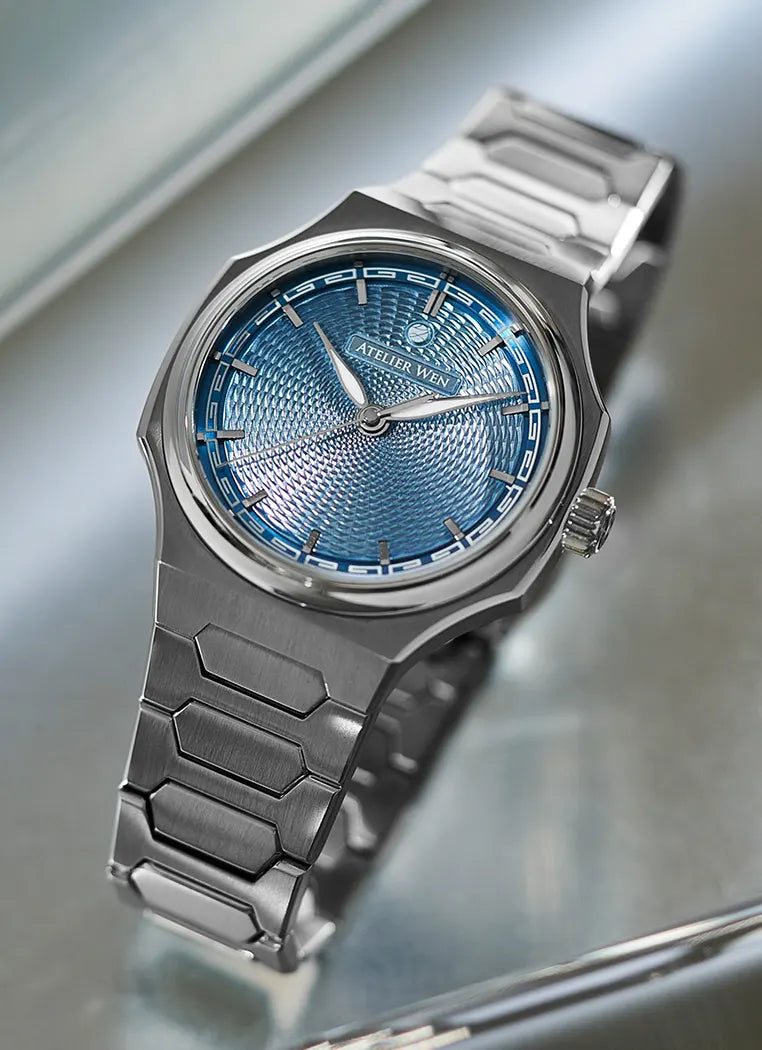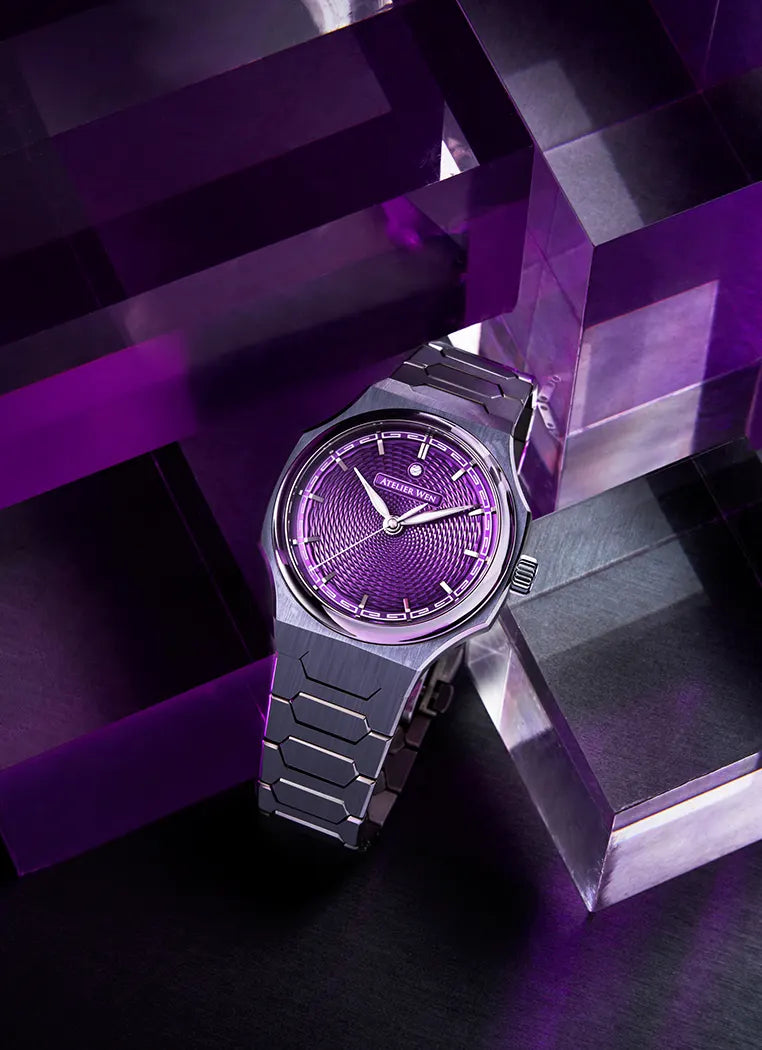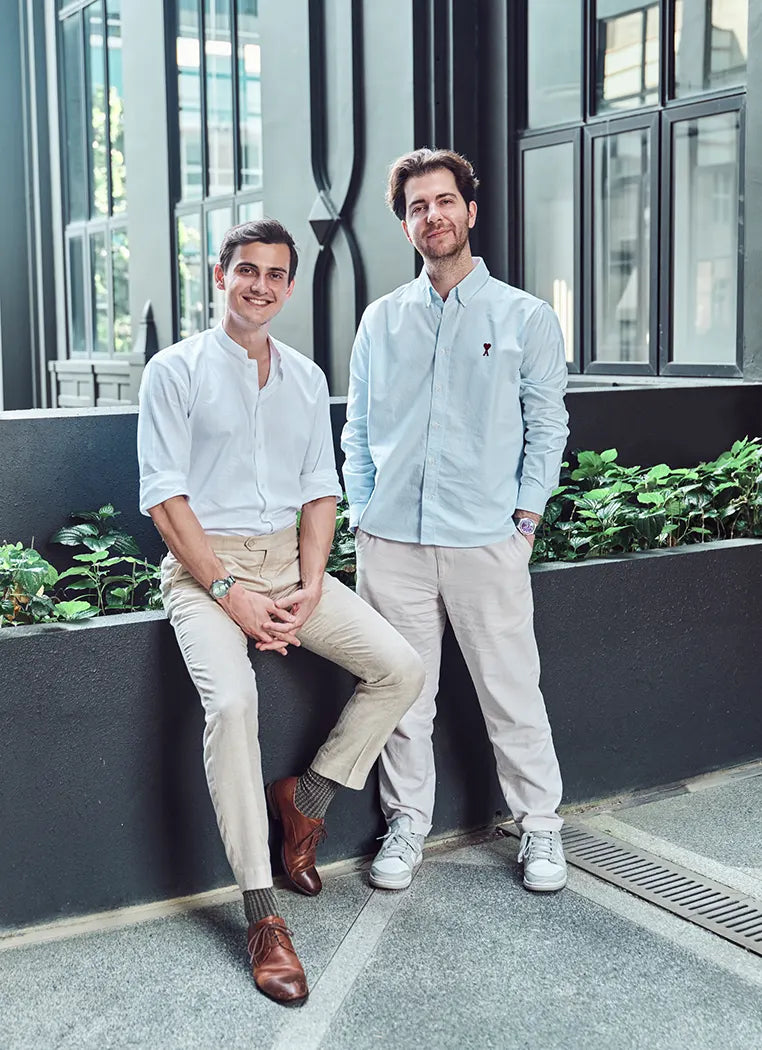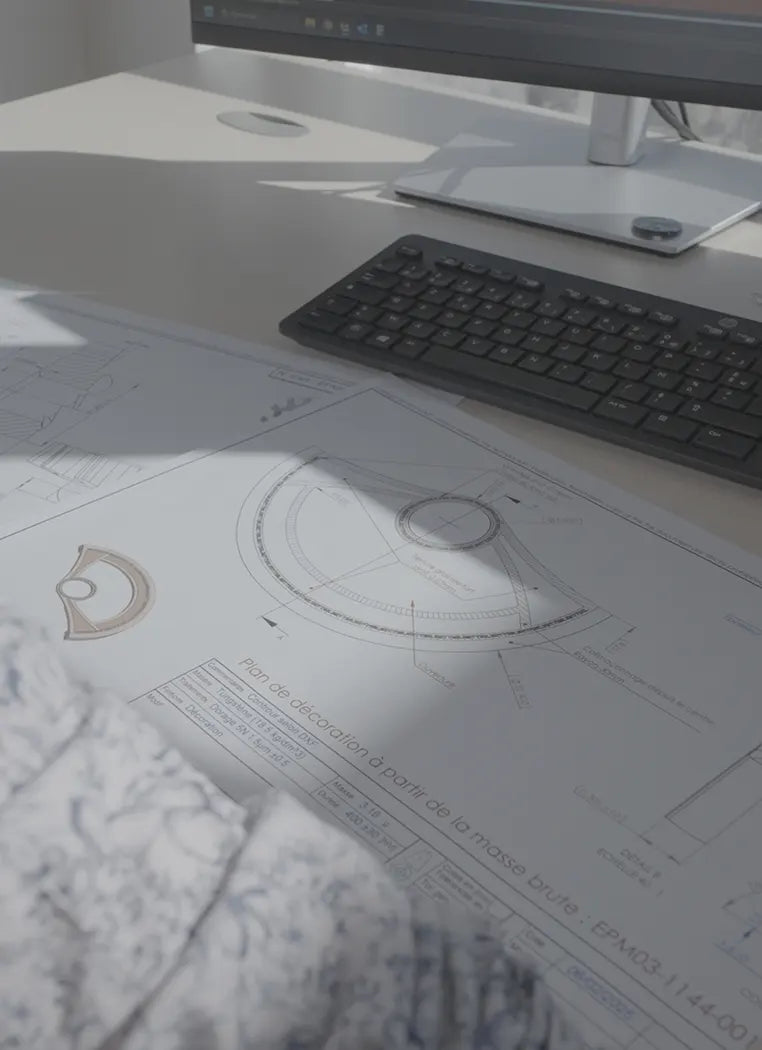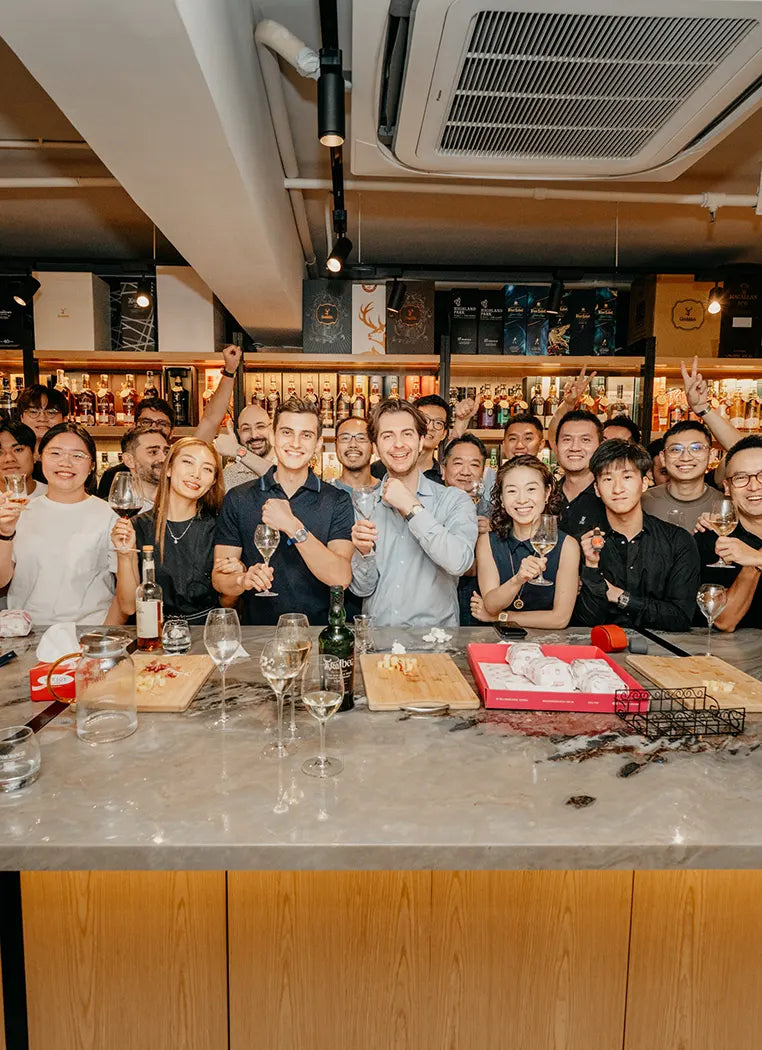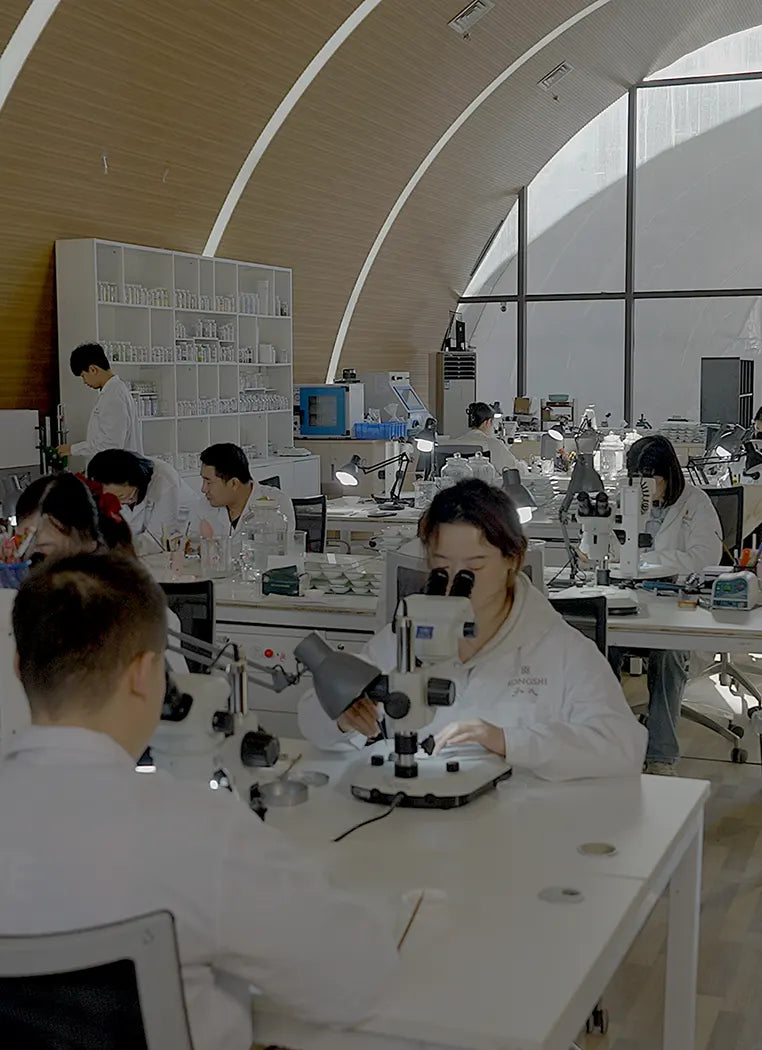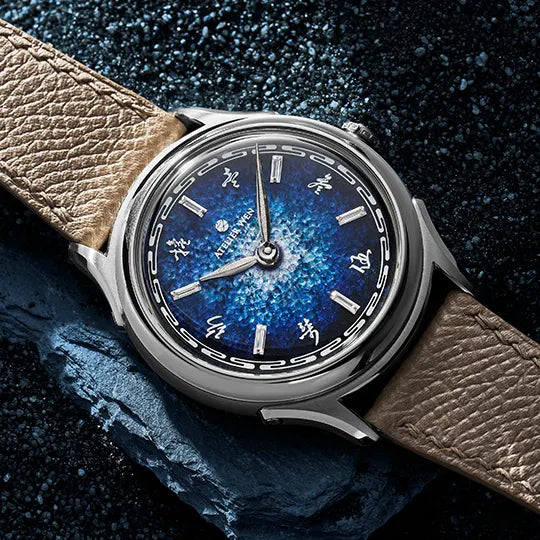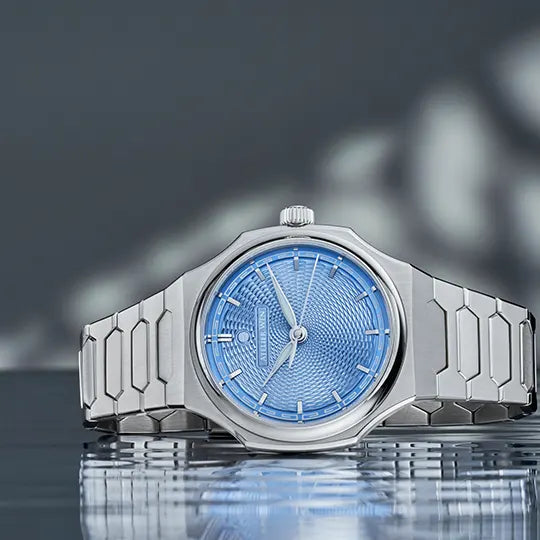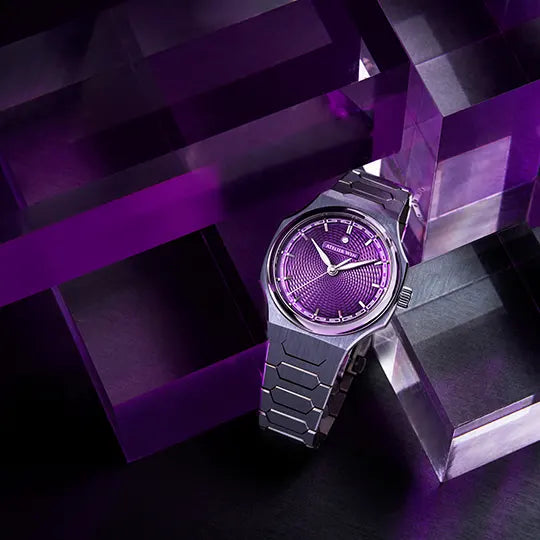Hey everyone, it has been a minute, but at long last, here is the well-overdue update that relays all that went on during our first ever exhibition in Geneva, during Watches and Wonders this year! The dust has well and truly settled around the biggest watch week in the yearly calendar, and we would, firstly and foremostly, like to extend a belated thank you to those of you who took the time to join us at our booth and visit us during the festivities. It was lovely putting many different faces to names (and/or Instagram accounts), and your enthusiasm for the brand was truly instrumental in a successful first outing in Geneva for our team!

Many of you have asked us for a play-by-play of the unfoldings there, so here it is — just a little later than intended!
For the first time ever back in April, our Atelier Wen team, along with our ever-present biggest fan, Justin Lam, was present in Geneva throughout the duration of Watches and Wonders, exhibiting at the Hotel Beau-Rivage alongside an assortment of other cool independents.

Also accompanying us on this occasion of many firsts was a certain guilloché master craftsman who spent the week turning dials live in the very heart of the world’s watchmaking capital on no less than his maiden voyage out of China!

It was, in many ways, an exhausting week, but it was also truly heartening to see the excitement held towards our brand’s direction, and the reception and warmth that we were met with. And while the novelties we intend to unveil this year were not quite over-the-line in time for the fair, we did bring with us the evidence of some exhilarating projects that are just on the horizon for our brand.
Chief of these was, of course, the tantalum proof-of-concept that we unveiled at our booth to much chatter and buzz. This, alongside Master Cheng and his rose engine, meant that over the five days we spent in the Salon Impératrice, we were treated to a constant stream of curious visitors — among which were many familiar names that we were meeting face-to-face for the first time!

But the eventfulness of our exhibition did not, in fact, begin at the hotel Beau-Rivage. Nor did it only start the moment we physically set foot in Geneva. Instead, the endeavour began more than a month before in a little town called Xinmi…
A bump in the runway, and then some.
It is fair to say that our plans got off to a tricky start. With nearly half-a-tonne of rose engine to transport halfway around the world, this was hardly a surprise. But what did catch us a little off-guard was the time it would take to make this happen. Robin began the search for a reliable way to move Master Cheng’s behemoth from the rural surroundings of Xinmi into the centre of Geneva well in-advance of the exhibition. But with the paperwork dragging on and our initial options falling through, the costly decision was made to transition from moving the engine by sea or rail, to flying its heft into Zurich before subsequently ferrying it by truck down to Geneva.

The rose engine itself was not actually one that had been long in-use by Cheng and his team, for the sole reason that it was, in fact, just half a year old. With the majority of his regular engines weighing close to a full tonne — and therefore, being near-impossible to actually transport, Cheng had set out to construct an equally functional, yet far more portable rendition of his machine with the express purpose of our exhibition in mind. The “lightweight” 450 kg/~1000 lbs of engine-turning apparatus that accompanied us to the Beau-Rivage was therefore a truly remarkable achievement in itself.

As April drew near, Cheng and his team got to work creating a custom wooden crate that would hold the engine and prevent it from shifting around during the long journey there. The hope was that this crate would ultimately protect it during its journey abroad — though as you will soon find out, it turned out to not be quite enough.

Alongside the drawn out arrangements for the rose engine’s transportation, an obstacle of an altogether different nature reared its head; and one that proved obstinately troublesome. There was, after all, little use in conveying the machine by itself all the way to Switzerland if it were not accompanied by its craftsman.
Yet it very nearly came to pass that we would arrive in the Beau-Rivage with a rose engine in the basement and no master to operate it, with Master Cheng thrice having had his Schengen visa application turned down; twice by the Swiss authorities, and then subsequently in France just a week before he was due to fly, despite us initiating applications nearly half-a-year in advance. With our entire exhibition and content programme having been shaped around his presence, the final few days leading up to our flights were an anxious scramble as we explored every possibility and reached out through a dozen different avenues in an attempt to re-initiate the visa application and expedite the process in the final days.
At long last, we managed to secure an expedited appointment the day before the flight, and Master Cheng was whisked off to Beijing to submit his documents and await the results. And wait we did, with no news coming our way all through the night. Finally, a mere four hours before Cheng was meant to board his Air China flight, he got the call — his visa had been approved, and he was heading to the land of guilloché masters and fondue! And that was the end of the ordeal, or so we thought…

Amidst our frantic attempts to make arrangements for Cheng’s travel plans — and in lieu of the uncertainty on the visa front, we had pre-booked several different flights as a last resort in the hopes that we could procure approval from either France or Spain before connecting him through to Geneva. And having left two separate flights on the docket to the last, it so-happened that at the check-in counter, Cheng was mistakenly dispensed the tickets bound for Paris. It was only thanks to our eagle-eyed co-founder, Robin, that this mistake was caught and spotted in the video that Cheng had sent to us to confirm he had gotten his (wrong) tickets. We were then fortunately able to get his precious suitcase diverted to the correct plane, and the tickets accordingly exchanged for ones bound for Switzerland.
And of course Cheng arrived, true-to-form, with a suitcase full of Baijiu in tow — all ready to introduce his absinthe-drinking Swiss counterparts to his own choice elixirs!

Here, a big shoutout needs to go out to both Baudouin van Es of Tourbillon Watch, and Max Bertin-Mourot of Extropian Watches who both provided us with invitation letters for the Swiss visa at various points of the process.
Tricky, tricky tantalum and building the booth
Securing Cheng’s rose engine and visa were not, of course, the only challenges as we prepared for the exhibition. There was also the significant obstacle of securing and organising the booth, and then arranging for our displays to be created. The visual spectacle of the rose engine meant that there were initial concerns from some of the other brands we were sharing the room with — that it would overshadow them a little unfairly. After some persuasion and reassurance from Robin that the engine would be practically noiseless, and that its relatively small footprint would fit nicely into our allocated space, they finally relented.


And so began the planning for how our booth would be structured and what our displays would look like. After some rudimentary initial sketches and several rounds of refinement through the team’s feedback, we resolved to construct our display stand in the semblance of our unfolded prismatic presentation box.

A big thank you goes to Arthur from Bangkok, Thailand, whose workshop refined and rushed out the entire stand for us within the span of three weeks!


Then there was also the small issue of curating what was on display. While we had decided fairly quickly that all versions of Perception came along with us, along with the trial dials and tantalum prototypes, the logistics took a bit more than simply making a decision. Robin and Ricky, our Supply Chain Manager, spent a whole lot of time liaising and chasing up with both the suppliers and our shipping partners to ensure that everything was ready in time. This was especially so with regards to the tantalum pieces as this was the first time we had executed fully in the metal, and there was no guarantee of their readiness.
The eventual trio of tantalum samples that we ended up displaying at the booth were ultimately the result of a long and arduous process of trial and error and blind R&D. In the first place, none of our partners in China had any notable experience in working the material to a high degree of finishing. Above and beyond that, if we were to discount the creation of a handful of singularly produced unique pieces, the idea of a reliably and scaleably manufactured watch bracelet in full-tantalum was little more than a distant dream in watch manufactures the world over.
Beginning nearly a full year prior to Watches and Wonders, we initially set out with more than ten separate manufacturers in our attempts to crack the complexity of creating a tantalum bracelet. Most quickly dropped out of the running, and this number was eventually whittled down to just two that succeeded.

Now, one might ask why we had been so adamant to rush the prototypes out before Geneva, and to pour so much extra effort and cost into the production of them. The truth is — and most brands can probably attest to this — that there is always a certain insecurity that comes along with the development of a new product, and especially so in one as monumental as this. The fear that another brand is developing something similar and in-parallel, and could release it before us is not easily shaken. And should that brand happen to be one of the big boys of the industry, with far more capital for development and executional manpower, then our own lengthy and costly developmental process would all have been for nought, with their release likely overshadowing ours, and the prized title of being “the first across the line” snatched from our grasp. And while these fears ultimately proved to be unfounded, they were clear and present at the time, and so rush we did to have those hefty proofs-of-concept available for viewing in the Beau Rivage.
The very first prototypes from each of the two partners were readied just one week before our exhibition was due to kick off, and they were rushed, post-haste, to Geneva — arriving exactly one day prior to the fair’s beginning. And alongside them, the individual constituent parts of our booth gradually fell into place in the days leading up to our exhibition. All things considered, however, things went as smoothly as they could have. Beyond the heart-in-mouth moments of Cheng’s visa debacle and the lengthy development of the tantalum prototypes, we were all set for our very first participation in Switzerland!
Two masters and a museum
To be entirely accurate about our timeline in Geneva, our Atelier Wen crew actually arrived three days in-advance of the exhibition proper. There was a lot of setting up to do at the hotel, but alongside that, we felt it was also a tremendous opportunity to give Master Cheng a little bit more of a taste of this new, unfamiliar country, as well as take him to visit another master guillocheur. Naturally, the logical choice was to attempt to engage the very best. Leading up to the shoot, we reached out to several massively important master artisans in the recent history of the craft — including the likes of Audemars Piguet’s Marc Ferland and the legendary George Brodbeck himself. But though we were unable to secure audiences with either owing to the general busyness of the period surrounding Watches and Wonders, we did succeed in landing a visit to perhaps the biggest name of all.

And so it came to pass that on the morning of the 8th of April, we set off to the mountain-top atelier of a certain Kari Voutilainen. Those of you even remotely familiar with guilloché as a craft would undoubtedly know of the man whose brand and workshop(s) are synonymous with it in this modern era. It was nothing short of a treat to be able to step behind the scenes and experience the process behind the crafting of his masterpieces, and even more so, with Mr. Voutilainen personally taking us through each room as the windows overlooked the magnificent surroundings of the Neuchatel countryside.

It was perhaps unsurprising that our own master guillocheur was buzzing with excitement, spending ample time to fully take in the century-old machines that Mr. Voutilainen employed throughout his atelier, and ask him about the tools that preceded his own in the craft. In fact, so great was Cheng’s engrossment with the machinery that we could only barely usher him from point to point to keep up with the tour, as he took copious mental notes on the differences between his own work and that of one of the foremost masters in Switzerland. He took a particular interest in a specific screw-thread on the straight-line engine there, remarking excitedly that this was a useful feature that he had thought of previously, but was as-yet unable to implement in his own engine — though he hoped to change that in the near future.
The two masters also conversed at length, via Wilfried’s translation, exchanging ideas and technical notes, while making brief comparisons on their different approaches to pattern depth, engraving material and rose engine architecture. Mr. Voutilainen’s workshop, for instance, chose to employ tungsten-based engraving blades that were less brittle. Cheng, meanwhile, elected for diamond blades that, while arguably allowing for a theoretically higher ceiling, were also extremely brittle, and increased the failure rates of his workshop’s dials significantly.

Machinery aside, Cheng was also astounded by the scenery that the Voutilainen atelier was immersed in. He marvelled constantly as we turned corners to uncover different angles of the valleys and hills that sprawled out beneath the compound’s vantage point. This, he remarked more than once, was something he would aspire towards, in curating his own workshop’s already lush surroundings to encapsulate some of the Chinese mountainside into which it was built when he got back to Xinmi. And when it came time to depart, Cheng extended the invitation for Mr. Voutilainen to visit if his travels ever took him that way.

Leaving the atelier behind, we then made our way further north to meet the lovely Nathalie Marielloni, vice-curator of the Musée International d'Horlogerie (MiH) in La Chaux-de-Fonds. The brutalist facade of the museum sets it apart from the rest of the city’s architecture; a nod to perhaps the most famous name it has given birth to historically; the legendary architect and designer Le Corbusier.The collection housed within the museum is widely regarded as one of, if not the most significant and extensive accumulations of horologically significant artefacts in the world — including two rose engines dating almost 400 years back to the mid-17th century. And as Nathalie showed us around the museum explaining the various exhibits and timepieces, our dear Master Cheng wandered off and discovered them on his own, to see some of the oldest precursors to the 7-month-old rose engine that stood, at that very moment, in the Beau Rivage.

Besides giving Cheng the opportunity to take a peek at these antiquities of immense importance, the primary reason we had for actually made the trip up to La Chaux-de-Fonds was the donation of a very special Piao, engraved on the back with the words “Cheng Yucai pour le MIH (for the MiH)”, to the museum. Cheng presented this proudly to Nathalie, and for us, the intention is very much that this watch serves to emblematise the continuation of the guilloché tradition, and place Master Cheng and China on the map of represented countries — as a stronghold for this craft in the years and decades ahead. For those of you who have the opportunity to swing by the museum, do keep an eye out — you might just chance upon Perception sitting amongst their esteemed array.

While this honour of having Perception featured in MIH brings us immense pride as a brand, what is absolutely more important about their acceptance of the donation are the potential ramifications it could have on Cheng’s standing. The fact that Cheng’s work is now being showcased in an international horological museum of such repute significantly boosts the chances of his craft being recognised as intangible cultural heritage on a national level. It therefore also makes him eligible to apply to become a representative of intangible cultural heritage in China — which is truly an immense honour!
Delivery damage and five days in the Salon Impératrice
Before long, it was time for the exhibition-proper, and as we went about setting up our booth and unpacking the rose engine, we were greeted by a truly awful sight. In the process of its transit into Switzerland, the stopper that was meant to keep the rose engine’s heavy brass rosettes from rotating had completely shattered under their weight, and in the process, it had also torn deep gouges into the wheels, rendering two full set of rosettes completely unusable.

With each individual brass plate taking approximately 20 days of moulding and refining, this naturally should have cast a momentary shadow on Cheng’s mood. But instead of dwelling on it, our indomitable master sprung into action, assessing the damage and quickly determining that he could still turn patterns using the undamaged sets of plates — and that all we needed was a replacement set of generic bearings that had shattered within the stopper. You would think that Geneva, being the heart of the watchmaking industry, would be the easiest city within which to find such a routine component. But despite getting some quality recommendations, we found ourselves bounced around between three separate locations before we finally found the parts we were looking for. The store in question was outside Geneva itself, about halfway to Lausanne, and boy did Cheng love that store. He was utterly enthused by the sheer variety of ball-bearings, and marvelled at their quality, as well as the fact that they were being sold along the side of a highway in the middle of the rural Swiss countryside! There was also more than a little relief on our part, since the rose engine was quite integral to a special little project we had set in motion at the fair.


In a nutshell, our Beau Rivage showcase was a whirlwind of interactions with fellow brands — including the likes of Baltic, Furlan Marri, Space One, Nivada Grenchen, Vulcain, Maison Alcée and Utinam, as well as collectors and retailers in full flow. Between sharing our projects with new friends, catching up with old ones over glasses of Moutai, and exploring new possibilities with partners of every kind, it was entirely intoxicating being surrounded by what was effectively the majority of the watch industry concentrated in one city. And while we could go on and on talking about the 5 days, the following pictures are perhaps a better vehicle to convey the experience!





We will be sharing more of the experience with you very, very soon with the next episode of Inside the Atelier!

Our visit to Mr. Voutilainen’s atelier was even repaid in-kind, as he came by our booth on the third day of our exhibition to take a peek at the rose engine that Cheng had built and extend the conversation from several days prior.
And not to forget the ones of you who stopped by at our little soirée at L'Alambic for cocktails on our second evening at the fair! It was truly a pleasure bringing Master Cheng all the way across the world to share an evening of indulging in several pours of his favourite Moutai with you all!





Crafted in China Geneva

Having a rose engine at the exhibition booth is, of course, an impressive piece of furniture, and even more so when you have a master guillocheur on-site to turn it. But aside from its function as a showcase of our capability in the craft and an opportunity for those passing by to momentarily experience the difficulty of engine-turning, one of the primary reasons why we had been so desperate to have a functioning engine at our booth was because it had been our intention from the start to have Master Cheng turn several complete dials on-site at the Beau Rivage.
The constant human traffic and consequently high levels of noise and vibration made this task far more difficult than it would have been in the sanctity of his cave-workshop back in Xinmi. However, despite the increased failure rate, Master Cheng actually managed to create three complete and unique dials — each with a different pattern — at the booth over the course of our 5 days there, and these were carved out of pure silver dial blanks.

Each was assembled locally by Swiss watchmaker Fabiano Pericles, at his workshop, Atelier Des Doct'Heures, in the Old Town of Geneva, making them the only ostensibly Swiss-made Atelier Wen watches ever made since they met the tag's qualifying criteria.
Cased in 904L steel, the casebacks of these watches point satirically to this fact, with an engraving that strikes out the word "China" in favour of "Geneva" in its attribution. The idea behind this was to convey how very little the geographical appellation of a watch truly is, since Cheng would have been turning the same dials in China just the week before, with the watches also being assembled there.

The dials were each left in raw silver and brass, and as each of the dials turned at our booth was carved in a different guilloché pattern, each watch is a pièce unique.

Two of the three watches have been gifted — to Cheng as a memento to remember his time in Geneva by, and to Time and Tide’s Andrew McUtchen, respectively. And we're extremely proud to say that the sole unique piece that went up for auction with Phillips fetched a record sum for any of our watches — of CHF 15,240. It will be the only instance in which one of these watches will ever come up for sale, and all the proceeds of this sale have been pledged to UNESCO in support of their efforts to preserve intangible cultural heritage in China. This feeds back into our brand’s core mission which is the preservation and progression of Chinese craftsmanship and culture, and this is something that we will continue to take extremely seriously.
A first taste of tantalum
Then, of course, there was our not-so-little teaser of the use of a certain rare element that, we are proud to say, caused a little bit of a stir during our time in Geneva.

Tantalum is not a material used frequently in watchmaking — with our recent collaboration with Grail Watch representing the very first time a fully-braceleted timepiece has been serially executed entirely in the material!
Being both a fairly rare metal, and one that is notoriously difficult to work with owing to its unique combination of natural hardness and density, the execution of fine finishing on tantalum requires far more extensive work than other softer metals — including the likes of gold or platinum. When machined, its outer surface turns sticky when machined, clogging up abrasive tools and pads very quickly and requiring constant changing of tooling componentry.
Our achievements with the metal were therefore something we were, naturally, tremendously excited by and proud of, and the exhibition at the Beau-Rivage gave us the perfect stage to debut the initial proof-of-concept prototypes of this endeavour, with three fully-functioning tantalum versions of Perception — each housing the same purple guilloché dial that you saw in our release of Perception 睦 (Mù) in recent weeks!
These will not, however, be the final form of our tantalum release, and were created merely to showcase our mastery of the material. The actual release of our tantalum model will fall under an upcoming line that we are dubbing the Perception Concept, and while these will share the same design DNA as Perception, they will feature an all-new case, bracelet and dial, amplifying the architectural inspirations behind the piece and celebrating new traditional crafts!

Our target volume for the first year of production in 2025 is upwards of 200 pieces, and the Concept will also be introduced as a permanent collection rather than a limited edition, giving ordinary collectors access to a material that has previously been reserved for those who dabble in the realms of unobtanium. Even without the bracelet, the production of tantalum pieces has generally been restricted to extremely small quantities in limited runs, and this will therefore also be the first instance a tantalum piece is made at a far larger scale — a feat that will unquestionably take some topping.
It has been a long journey getting to this point, with our material trials stretching across the past two years, and we have worked extremely hard with our partners on perfecting the polishing and finish of the metal. And though we are not quite over the finish line, the reception to these full-tantalum prototypes that we showed off in Geneva has already been truly overwhelming, and we have received quite the deluge of requests for the piece despite having not-yet finalised the actual design!
Needless to say, we are tremendously excited to have piqued the interest of so many discerning collectors with this preview at our exhibition, and we cannot wait to realise the release of our Perception Concept in this exceptional material!
The road ahead
With the above in mind, many of you would naturally be wondering what our roadmap looks like for the upcoming months. You can be sure that we are absolutely forging forward as quickly as we can to get the various projects that we are currently working on over the line and ready for your collections.

We hope to formally launch the Perception Concept in Q2 2025 — once a further round of prototyping has been completed. Furthermore, while this was a project that we teased through our participation in the Genevan festivities, it is far from the only one that is well-underway, and we will have several more exciting announcements to make in the months to come!
We will keep these other cards a little closer to our chests for now, but do keep a lookout, as Perception will soon have some company in our brand's ongoing catalogue!
To conclude…
Geneva presented us with the wonderful opportunity to finally introduce Cheng to the wider watch world. While the whole process — from shipping his rose engine and getting his visa cleared to ensuring that we had the constituent parts ready to make the exhibition a success for our brand — took a herculean effort from all parties involved and came with a few hiccups and lessons along the way, it was absolutely worth it. Between enabling us to give Cheng the experience of a lifetime on his first trip out of China, and allowing us to truly shine a spotlight on his work as both a craftsperson and a partner who has been so integral to the success of our sophomore release in Perception, it was an deeply meaningful endeavour that we hope to extend to the different craftspeople we celebrate in the releases to come.
Before this update is through, we would also like to extend the warmest welcome to the latest members of our growing team, Alexandre Truong, Alfred Chan and Justina Goh!

Alexandre Truong arrives from Montreal, Canada, as our new Head of Digital Growth! A seasoned digital marketeer, his career has taken him eastward across three different continents — through Paris and now to Singapore! Prior to joining the team, he spent 8 years with Meta (then still known as Facebook), and spent the majority of his time servicing and growing some of the largest luxury brands in the world. He brings to us an extensive skillset in digital advertising, data analytics and partnerships — so if you see our content a little too often, you know who to blame!
He is also a self-professed nerd when it comes to tech, gaming, travel, design and fashion!

Alfred Chan needs no introduction as the designer who, among many other things, is responsible for the case and bracelet of Perception! While he has already worked with us for pretty much half a decade on a freelance basis, he now joins the team part-time in official capacity as our mainstay designer! His works have been well-lauded across the watch world, with his most recent accolade being a GPHG nomination in 2024 as the “Chan” in Toledano and Chan, and we are extremely proud to have him onboard!

Our new Customer Experience Associate, Justina, hails from Penang and boasts considerable experience in customer support and client account management across various industries. She has previously handled multiple key clients and finds immense joy in helping customers meet their needs. She also has previous experience in the service industry, and is excited to employ her expertise in assisting each and every one of you to the best of her abilities!
The team And once again, a big shoutout goes to Justin Lam — our perennial supporter who flew all the way out to Geneva to join us behind the booth. We would also like to thank Baudouin van Es, Kari Voutilainen, Nathalie Marielloni, Bryan Paradiso, Yoann Roig, Elise Gyger, and all the other individuals who helped make this happen!
And of course, one final one to all of you — for your continued support and passion that keeps this project going and enables us to push on towards bringing the very best in Chinese watchmaking to you!


